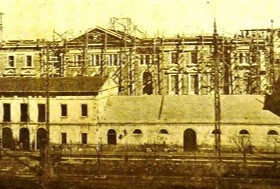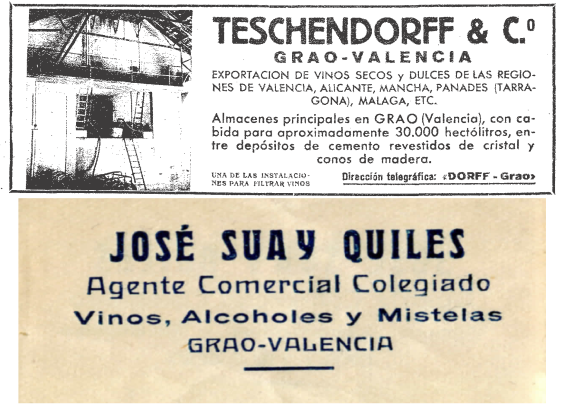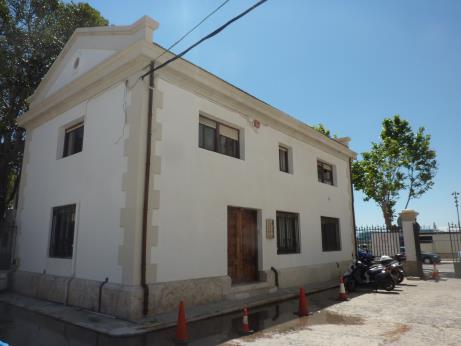
“Everything is very mixed in these neighbourhoods, and perhaps they owe their particular flavour to it. Needless to say, there is the port and its hustle and bustle of loading and unloading and its inevitable «underworld»; there is an imposing factory activity, in which naval buildings –upscale shipyards– uniquely stand out; there is the “and they still say fish is expensive!”, from humble and risky boats; there is the restaurant industry, the refreshments stands one, the spa one, more powerful every day; there is, even, the peasant aftertaste, with the orchards so close…” (J. Fuster, 1971).
The seaside towns of Valencia have a rich personality, linked to the port and the sea, but to the orchards and the city as well. The presence of workers, fishermen, industrialists, traders and visitors is reflected in an urban plot of great architectural value, as well as in various areas related to science that must be preserved, studied and protected. The so-called “spatial turn” in science allows you to analyse in detail a wide variety of scientific spaces as well as to build bridges with other areas such as urban history, architecture, geography or environmental history. The deep relationships between urban history and scientific, technical and health activities are reflected even in toponymy, such as the Malva-rosa, which owes its name to the perfume factory based on the cultivation of the Alcea rosea or hollyhock flower, which was established in 1856 by Jean Félix Robillard Closier (1812-1888), a French botanist and former chief gardener of the Botanical Garden of the University of Valencia. Another toponymic example of that area is related to the spread of diseases. In 1720, in order to avoid possible epidemics in the city, a small lazaret (‘llatzeret’) was built on the southern edge of the mouth of the Turia river, where boats, crews and passengers suspected of suffering a health problem went through quarantine periods. Over time, the word llatzeret (‘lazaret’) evolved and became Natzaret, name of one of the current seaside neighbourhoods. The Indústria (‘industry’), Boters (‘coopers’) or Vaixell (‘ship’) streets are other memories of the scientific, technical and maritime activities of the area. Besides the lazaret, numerous health-related entities were established on the seafront in Valencia, such as the Sanatori Marítim de la Malva-rosa (‘Malva-rosa Marine Clinic’) (reorganised in 1934 to treat tuberculosis, currently Hospital de la Malva-rosa, ‘Malva-rosa Hospital’), and the Sant Joan de Déu old’s people home (currently Hispital València a la mar, ‘Valencia to the sea Hospital’), initially destined to cure scrofulous or disabled children. The proximity to the sea also implied that some buildings close to the beach were used for things different from those originally intended for them, like the former Fish Market. That building sheltered many of the soldiers wounded in the African war and became the Evacuation Hospital of the Cabanyal in 1921, due to the intensification of the colonial war on the Riff. Spas are another example of the scientific and medical heritage of the seaside towns. They started to become popular in the mid-nineteenth century. Sanitary practices and recreational activities were combined there. There are news about the existence of eighteen beach huts for women and fifteen for men on the beaches of the city of Valencia in 1851. Shortly after, they began to install floating spas, such as La Florida (1863) or La rosa del Túria (1869). The serious safety and buoyancy problems of such wooden structures led to other more solid buildings in which more diverse treatments and activities were offered, like the Les arenes spa (built in 1887 and renovated in 1917), or Victòria baths (opened in 1918 and converted into a nightlife venue).
In addition to the entities linked to health, there were numerous industrial activities in the area surrounding the port of Valencia. Due to the progressive growth of the port, a great movement of goods and merchandise that were sent to different places was created. The Grau railway station had the main mission, until 2005, of the merchandise movement, which is why it was located as close to the sea as possible. It was opened in 1852 and it is the oldest preserved station in the Iberian Peninsula. It initially connected the port with the city centre, but in 1854 it was extended and reached Xàtiva and in 1859 it reached Madrid. This station has a great patrimonial value, since it keeps the unloading docks built at the end of the nineteenth century, as well as the remains of the roads and the links to the port. The growth of the commercial activity of the port of Valencia established in the area a series of services higher than the one in other similar population centres. The improvements in the drinking water supply (1859), gas lighting (1868), the tram service (1876) or the installation of a telegraph station (1878) are examples of it. However, the creation of such a wide network of industries and services should not be related to a unique and optimistic vision of modernity. Urban environments also became spaces for social struggles, political demands, marginalisation and complaints about several problems caused by this supposed modernity. In the case of the maritime district, industrial growth has won many valuable assets, but has also caused several problems that are still maintained today. An example of this is the pollution caused by handling toxic substances such asbestos, which not only affected former shipyard workers and other ancillary industries, but also their relatives and neighbours (many of them members of associations such as ADV-València). This harmful product, banned since 2002, is still present in the body of many people and in numerous public and private buildings and facilities, and the updating of the affected censuses and the progressive withdrawal of this material inheritance is demandable.
Inside the port area there was a great commercial activity but also a scientific one, mainly related to the regulation and the control of people, products and merchandise. Due to the growth of the port and the cholera threat, an ancillary lazaret was built inside the port at the beginning of the nineteenth century, which was improved and consolidated until it replaced the one in Natzaret until 1848. The creation of a new network of lazarets in Spanish ports was part of the new laws of health of the liberal regime. These also created in 1855 the body of delegates of external health. It was a body of medical experts, specialised in maritime health. The same law also established the body of inspectors of medicinal genres, formed by doctors and graduates in pharmacy who worked in the main customs of the country (figure 1). Its functions included aspects related to health, chemistry and finance. In addition to recognising medicinal drugs and imported chemicals they should inform the customs administrator if they detected any adulteration of these products that would cause fraud to the public treasury. Despite the prestige of many of these pharmacists, they had little means and, as with doctors of external health, they made their appointment compatible with their main activity, as was the case of the first inspector of medicinal genera of Valencia, the pharmacist and deputy Vicente Peset Vidal (1821 -?).
Many recent works on the history of science have shown the profound existing relationships between the personal and professional interests of many scientists and the needs of their local contexts. Product regulation is an example of the variety and complexity of interests at stake in the world of science. Wine and orange exports are an especially important activity of the port of Valencia, due to the prominence of both products in the local economy. As we will show later, the control of the wine meant the majority of the analysis performed at the Valencia customs laboratory. On the other hand, orange became from the 1920s the most exported product from the port of Valencia, both in terms of the quantity embarked and its monetary value. The economic impact of the Valencian citrus sector caused this product to become the country’s main source of currency. The economic impact of the Valencian citrus sector caused this product to become the country’s main source of currency. Therefore, the farmers themselves as well as the local authorities and the government were very interested in ensuring the smooth running of this market. Agricultural producers and exporters, with the support of agricultural engineers and small-scale farmers, demanded the creation of systems that managed to ensure the quality of the exported products. An example of this double interest was the creation in 1934 of the Official Service of Inspection, Surveillance, and Regulation of Exports (SOIVRE). This body had the objective of controlling the quality of exported agricultural products in order to increase its commercial value. His main promoters were the Valencians Vicente Iborra Gil (1898-1964), agricultural entrepreneur and general director of commerce, and Rafael Font de Mora Llorens (1893-1978), a prestigious agronomist engineer. To exercise the functions of surveillance, inspection and regulation of exports, five areas of activity of the SOIVRE in Spain were established. The area called Llevant was the most important one, since it had secondary offices in Valencia, Castelló, Alacant, Borriana, Gandia and Cartagena, as well as a staff of nineteen engineers and experts (50% of the national total). Shortly after this body was created, the Phytosanitary Station of the port of Valencia was opened, to which eight technicians were allocated, mainly responsible for certifying the quality of the oranges dedicated to export.
The other star products of the Valencian export were wine, mistella wine and brandy. In fact, these had been the main source of foreign exchange until the 1920s, when they were surpassed by orange. Exporters of the nineteenth and twentieth centuries were mainly engaged in the export of wine in bulk. Their market dominance and control of the prices left little margin for the improvement of the elaboration methods from farmers and cellars, which in the case of the wines Valencia exported mainly came from Godelleta, Utiel, Requena and from bordering areas of La Mancha. In the 1970s there was a change in trend in some Valencian exporters and producers, who started to produce higher quality wine, with impeccable packaging and taking a brand policy into account. The wine trade grouped a complex network of public and private agents that circulated between different spaces, such as commercial offices, laboratories, cellars, patios to expose wines to the sun and filter them, warehouses for sunflower seeds, repair workshops for containers and casks and official institutions both in and outside the port. In relation to private actors, there were custom agents (in charge of preparing the debt, delivery or return of goods documents), and ship consignees (representing ship’s shipowners). Others were more specifically related to the trade of wine, such as intermediaries and commercial agents (such as Martínez Bermell, Algarra or Suay), local exporters (for example Gandia Pla, Mompó or Garrigós), and of foreign origin (like Schenk, Steiner, Egli, Teschendorff or Valsiangiacomo) (figure 2). The names of many of them are in the voluminous record books in the Valencia customs laboratory.

Figure 2. Advertisements of wine exporters and intermediaries of the Grau of Valencia in the 1930s. (Blanco y Negro, 26/01/1936, p. 146 and photo from the author)
The Valencia customs laboratory is also a good example of the great relationship between the economic interests of an area and the intervention of the authorities in their protection. The inspectors of medicinal genera, mentioned above, were not always able to analyse the growing variety of products that arrived at the ports. The main control of goods in customs was performed by the expert custom corps created in 1850. These expert employees inspected merchandise on ships and quays to identify the products and determine the taxes or duties that they had to meet. Inspections should be fast and simple and they used to only visually inspect the merchandise. In case of doubt they could resort to the pharmaceutical inspector, and in more complex cases, to the chemical customs office. The shipment of samples to this service, belonging to the Ministry of Finance, in Madrid, was expensive and complex. In 1888 this office was expanded and transformed into a central laboratory for chemical analysis. However, this new laboratory was not able to deal with the increase of goods moving around Spanish customs. Finally, in the 1920s the Ministry of Finance —advised by the director of the Central Laboratory, José Casares Gil (1866-1961) — decided to organise a network of customs laboratories at the most busy locations: Barcelona, Bilbao, Irun, Port-Bou, València, Sevilla and Tarragona.
The Valencia customs laboratory opened in 1927 and occupied a pavilion adjacent to the new customs, designed in 1925 (figure 3). Its first director was the Chemistry teacher at the University of Valencia León le Boucher Villen (1904-1937), to whom the Chemist Francisco Bosch Ariño (1902-1995) helped. These laboratories did have their own personnel and were better equipped than the laboratories in which the other pharmaceutical inspectors worked. During its first five years, the Valencia customs laboratory performed more than eleven thousand three hundred chemical analysis, of which only three hundred and sixty were of industrial products and miscellaneous goods, while all the rest were of wines, alcohols and mistella wines, which shows its relationship with the economic needs of its environment. In these trials, the density of the liquid was mainly determined, as well as the alcoholic content, in order to check its properties and determine the corresponding tax. The laboratory was used to set taxes or customs rights that exporters and intermediaries had to pay. But, on other occasions, it was used to strengthen the quality of local wines. An example of that is the role played by the customs laboratory on the occasion of the intoxication suffered by many sailors who transported a shipment of wine from the port of Valencia in France in 1932. The press and the French authorities accused the Valencian producers of producing wine with high levels of arsenic. This accusation was a serious threat to the prestige of local wines, so that the Spanish authorities were also deployed. In addition to other experts, such as agricultural engineers, the chemist Francisco Bosch used his work in the customs laboratory to defend the quality of Valencian wines, as well as to internationally defend them. During the Franco regime, Bosch Ariño was appointed director of the customs laboratory and he also held many institutional positions: professor of chemical analysis, dean of the University of Valencia, as well as Falange delegate of education, president of the School of Pharmacy and provincial deputy in the post-war period. The previous case, as well as that of the laboratory dedicated to the control of citrus fruits, shows how these entities not only had a technical function. Both services were a fundamental part of the surroundings of the port of Valencia. As other works on the history of science also show, scientific spaces were places where the interests of many social, political and economic agents that could motivate the creation of the services had to be taken into account, as well as influence their jobs. At the same time, the strategic importance of these scientific services offered its personnel the possibility of claiming the utility of their profession and even their own scientific prestige to accumulate merits and obtain positions later. For all this, the historical study of these spaces can help to consider them not neutral places or inert containers but as spaces in which they carried out scientific works whose impact transcended the activities that were done in the maritime towns, in the city and in the rest of the territory.

Figure 3. Picture of the Valencia customs laboratory. Picture from the author.
Ignacio Suay
Interuniversity Centre for History of Science and Technology (CIUHCT-UNL)
Personatges i espais de ciència (‘Science characters and spaces’) is a project of the Unit of Scientific Culture and Innovation of the University of Valencia, with the collaboration of the “López Piñero” Institute of History of Medicine and Science and with the support of the Spanish Foundation for Science and Technology and the Ministry of Economy, Industry and Competitiveness.

















